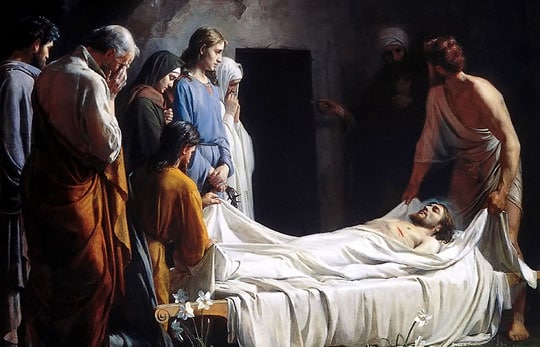Bible Question:
I have been discipling a new Christian and he comes up with some goodies! He has asked, “What is significant about the three days of Christ's death, burial, and resurrection?” Is the fact that there are three days and not two or four meaningful?
Bible Answer:
What is the significance of Jesus being dead for three days and nights? Scripture never directly answers the question, but what follows are three insights. For a discussion of the meaning of the phrase, “three days and three nights,” visit “Did Jesus fulfill the sign of Jonah? — Three days and Three Nights.”

Jewish Burial Practices
Perhaps the most significant reason for Christ being in the tomb for three days is that according to the Talmud (c. eight century), the Jewish burial practices tried to ensure that the dead were truly dead.
We go out to the cemetery and examine the dead [to see if they are still alive and have been buried by mistake] for a period of three days and do not fear being suspected of engaging in the ways of the Amorites [i.e., superstitious practices]. Once a man who had been buried was examined and found to be alive; he lived for twenty-five years more and then died. Another such person lived and had five children before he died. (S’machot 8:1)[1]
This means that according to Jewish custom, a person was not considered dead until after three days. According to “Did Jesus fulfill the sign of Jonah? — Three days and Three Nights,” the three days could actually be less than 72 hours.
It is important to note that forensic science states that after death rigor mortis – stiffness of death – sets in within 1 and 12 hours (average 2–4 hours).[2] The difference in time depends on the circumstances. Putrefaction of the body begins to occur after 36 hours.[3] This would have been common knowledge to the people of Jesus’ time since they witnessed dead people constantly while living under the control of the Roman Empire.
John 11 records the death and resurrection of Lazarus. When Jesus was ready to resurrect Lazarus, Lazarus had been dead for four days. In John 11:39, Martha objects to Lazarus begin raised with theses words,
Jesus said, “Remove the stone.” Martha, the sister of the deceased, said to Him, “Lord, by this time there will be a stench, for he has been dead four days.” John 11:39 (NASB)
Her response reveals that she understood that putrefaction would have been in process. When Christ died, the solder pushed a sword into His side to determine if he was dead (John 19:34-37). There is no doubt that Jesus was dead before He was buried. Therefore, Jesus’ body would have began to putrefy by late Saturday night. His resurrection on Sunday morning would have been a miracle.
Resurrection On First Day
Christ’s resurrection on the first day of the week signaled a new life. The early church recognized this and began meeting for worship on the first of the week (Acts 20:7; 1 Corinthians 16:2). All of the ten commandments are repeated in the New Testament, except the command to worship on the Sabbath. See the article “Do we have to keep the ten commandments given in the Old Testament?”
Conclusion:
Our God wanted us to know that a miracle occurred. Jesus’ human body was already decaying when the miracle of life returned. Jesus promised that He would rise the third day. Since the Roman soldiers and everyone else knew Christ was dead, His resurrection on the third was a true miracle.
References:
1. David. H. Stern. Jewish New Testament Commentary. Jewish New Testament Publications. 1992. pp. 190-191.
2. Study.com (study.com/academy/lesson/rigor-mortis-definition-timeline-stages.html).
3. Explore Forensics (ww.exploreforensics.co.uk/the-rate-of-decay-in-a-corpse.html).
Suggested Links:
Searching For GodShow Us A Sign
Should we worship on Sunday or the Sabbath?
Do we have to keep the ten commandments given in the Old Testament?
Did Jesus fulfill the sign of Jonah? — Three days and three nights